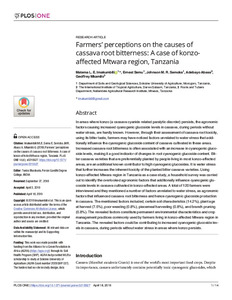| dc.contributor.author | Imakumbili, M.L. |
| dc.contributor.author | Semu, E. |
| dc.contributor.author | Semoka, J.M. |
| dc.contributor.author | Abass, A. |
| dc.contributor.author | Mkamilo, G. |
| dc.date.accessioned | 2022-08-05T13:14:16Z |
| dc.date.available | 2022-08-05T13:14:16Z |
| dc.date.issued | 2019-04-18 |
| dc.identifier.citation | Imakumbili, M.L., Semu, E., Semoka, J.M., Abass, A. & Mkamilo, G. (2019). Farmers’ perceptions on the causes of cassava root bitterness: A case of konzo-affected Mtwara region, Tanzania. PloS one, 14(4): e0215527,1-14. |
| dc.identifier.issn | 1932-6203 |
| dc.identifier.uri | https://hdl.handle.net/20.500.12478/7607 |
| dc.description.abstract | In areas where konzo (a cassava cyanide related paralytic disorder) persists, the agronomic factors causing increased cyanogenic glucoside levels in cassava, during periods without water stress, are hardly known. However, through their assessment of cassava root toxicity, using its bitter taste, farmers may have noticed factors unrelated to water stress that additionally influence the cyanogenic glucoside content of cassava cultivated in these areas. Increased cassava root bitterness is often associated with an increase in cyanogenic glucoside levels, making it a good indicator of changes in root cyanogenic glucoside content. Bitter cassava varieties that are preferentially planted by people living in most konzo-affected areas, are an additional known contributor to high cyanogenic glucosides. It is water stress that further increases the inherent toxicity of the planted bitter cassava varieties. Using konzo-affected Mtwara region in Tanzania as a case study, a household survey was carried out to identify the overlooked agronomic factors that additionally influence cyanogenic glucoside levels in cassava cultivated in konzo-affected areas. A total of 120 farmers were interviewed and they mentioned a number of factors unrelated to water stress, as agronomic factors that influenced cassava root bitterness and hence cyanogenic glucoside production in cassava. The mentioned factors included; certain soil characteristics (14.2%), plant age at harvest (7.5%), poor weeding (0.8%), piecemeal harvesting (0.8%), and branch pruning (0.8%). The revealed factors constitute permanent environmental characteristics and crop management practices commonly used by farmers living in konzo-affected Mtwara region in Tanzania. The revealed factors could be contributing to increased cyanogenic glucoside levels in cassava, during periods without water stress in areas where konzo persists. |
| dc.description.sponsorship | Alliance for a Green Revolution in Africa |
| dc.format.extent | 1-14 |
| dc.language.iso | en |
| dc.subject | Cassava |
| dc.subject | Varieties |
| dc.subject | Planting |
| dc.subject | Water Stress |
| dc.subject | Agronomy |
| dc.subject | Tanzania |
| dc.title | Farmers' perceptions on the causes of cassava root bitterness: a case of konzo-affected Mtwara region, Tanzania |
| dc.type | Journal Article |
| cg.contributor.crp | Roots, Tubers and Bananas |
| cg.contributor.affiliation | Sokoine University of Agriculture |
| cg.contributor.affiliation | International Institute of Tropical Agriculture |
| cg.contributor.affiliation | Naliendele Agricultural Research Institute |
| cg.coverage.region | Africa |
| cg.coverage.region | East Africa |
| cg.coverage.country | Tanzania |
| cg.coverage.hub | Eastern Africa Hub |
| cg.researchtheme | Social Science and Agribusiness |
| cg.identifier.bibtexciteid | IMAKUMBILI:2019 |
| cg.isijournal | ISI Journal |
| cg.authorship.types | CGIAR and developing country institute |
| cg.iitasubject | Agribusiness |
| cg.iitasubject | Agronomy |
| cg.iitasubject | Cassava |
| cg.iitasubject | Plant Breeding |
| cg.iitasubject | Plant Diseases |
| cg.iitasubject | Plant Health |
| cg.iitasubject | Plant Production |
| cg.journal | PLOS ONE |
| cg.notes | Published online: 18 April 2019 |
| cg.accessibilitystatus | Open Access |
| cg.reviewstatus | Peer Review |
| cg.usagerightslicense | Creative Commons Attribution 4.0 (CC BY 0.0) |
| cg.targetaudience | Scientists |
| cg.identifier.doi | https://dx.doi.org/10.1371/journal.pone.0215527 |
| cg.iitaauthor.identifier | Adebayo Abass: 0000-0003-1376-3608 |
| cg.futureupdate.required | No |
| cg.identifier.issue | 4 |
| cg.identifier.volume | 14 |

